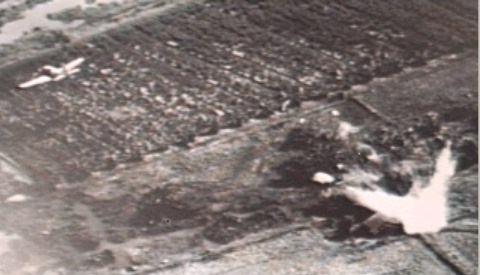

Operation Linebacker I
|
MAY 10--Operation Linebacker I, the heavy strike of targets in most of NVN, evolved and lasted until restrictions on operations above 20_ N were imposed 22 October. The operation was an outgrowth of Freedom Train and the President's mining declaration which also stated that the U.S. would make a maximum effort to interdict the flow of supplies in NVN. On this first day of Linebacker I, the Navy shifted its attacks from targets in southern NVN to the coastal region embracing Haiphong north to the Chinese border. In all, 173 attack sorties were flown in this region this day, although another 62 were directed into SVN in continuing support of allied forces there. |
 |
It was the most intensified air-to-air combat day of the entire war. Navy flyers shot down eight MiGs. An F-4 Phantom II, from VF-96 on board Constellation, while engaged in aerial combat over Haiphong shot down three MiGs for the first triple downing of enemy MiGs by one plane during the war. Lieutenant Randy Cunningham was the pilot and Lieutenant (jg) William Driscoll was the RIO of the F-4. These three MiG downing's coupled with their 19 January and 8 May downing of two MiGs, made them the first MiG aces of the Vietnam War.
Three other kills were scored by planes of VF-96 and one by VF-92 off Constellation and one by VF-51 off Coral Sea. During the five and one-half month period of Linebacker I, the Navy contributed more than 60 percent of the total sorties in NVN, with 60 percent of this effort in the "panhandle", two large regions between Hanoi and the DMZ. Tactical air operations were most intense during the July-September quarter with 12,865 naval sorties flown. Most attack sorties in NVN fell into two classes--armed reconnaissance and strike.
The former was usually directed against targets of opportunity with three main areas proscribed--near Hanoi, Haiphong and the Chinese border. Strike operations were preplanned and usually directed at fixed targets. Most types of fixed targets, not associated with armed reconnaissance, required approval by the Commander-in-Chief, Pacific, or by the Joint Chiefs of Staff, prior to attack. Principal Navy aircraft were the A-7 and A-6, which accounted for roughly 60 and 15 percent of the Navy's attack sorties, respectively. About 25 percent of the Navy's effort was at night. Carriers participating in the initial May-June operations from Yankee Station were Constellation, Coral Sea, Hancock, Kitty Hawk, Midway and Saratoga.
| ŠAvStop Online Magazine Contact Us Return To News |